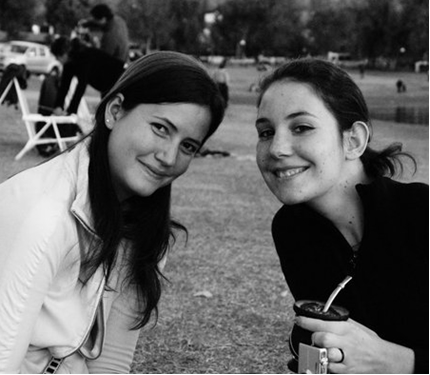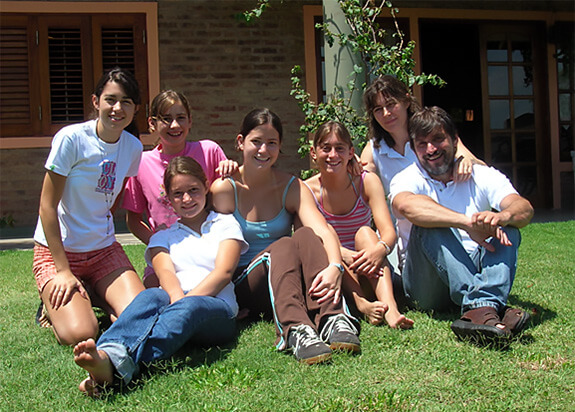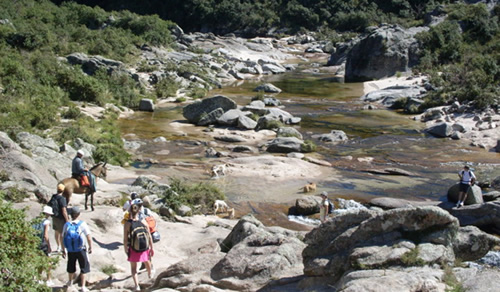Living Abroad and Choosing a Student Program in Córdoba, Argentina
La Vida Tranquila
Article and photos by Mary MacKenty

|
|
Drinking mate with a friend.
|
My Cordobesa host sister passes me the gourd, and its heat seems to penetrate my hands. I stare down at the silver straw poking out from the now-wet yerba mate plant leaves, unsure of how to proceed. I slowly suck on the straw, being cautious not to burn myself, but it comes up too quickly, and a bitter tea stings my tongue. My friends laugh at my reaction and wait for me to continue until the water is gone. I was obliged to be polite. I return the gourd to the server, which is refilled and passed along to the next person in the circle we have formed on the half-dead grass in the Plaza de La Intendencia. When it comes around again, I am unsure how to decline without offending them, so I fiddle with the straw. A collective freakout in Spanish ensues since moving the straw clogs it. I sip with apprehension, but this time, it feels slightly better.

|
|
The author's host family.
|
Within a week, drinking mate had become one of my favorite rituals.
Many “Yankees,” meaning people from the USA, known as Yankeelandia, ask me, “But don’t they pass germs sharing a straw like that?” According to my host mom, illness comes from the cold, and you can only get cured by drinking tea and wearing a scarf. Besides, in Córdoba, sharing is essential to the culture, especially food and drink. Drinking mate exemplifies this because it symbolizes an excuse to spend time with family and friends.
Why Córdoba, Argentina?
“Córdoba, isn’t that in Spain? I thought the only city in Argentina was Buenos Aires.” Approximately one-third of Argentina's population lives in Buenos Aires (and growing), another third lives in the province of Buenos Aires (and growing), and the last third lives in the rest of the country. Buenos Aires is a modern city with significant buildings, parks, statues, museums, tango, and culture. It has everything a student could want; however, Córdoba has an undeniably friendly atmosphere. It is for good reason that Córdoba is nicknamed “Corazón de mi país,” meaning the heart of my country. Everything is an excuse to be social, be it a cumpleaños (birthday party), despedida (going away party), bienvenida (welcome party), an all-day asado (barbecue), or just drinking mate. There are few foreigners in Córdoba, so locals are intrigued and excited to befriend them. It is also in their nature to invite everyone, everywhere.
During study abroad experiences, a student’s time in the country is limited. If you want to experience a culture and learn the language, it is critical to befriend locals. This is not a problem in Córdoba.
In Córdoba, most students live within the city center of Centro and Nueva Córdoba. You can walk across the center in 30 minutes, rendering the confusing bus system unnecessary. This makes it easier to drop by on friends or meet up in the plazas.
The abundance of nightlife will top off your social world. Typical nights start at 10 p.m. with a previa. The preferred drink of Córdoba, fernet with coke, is drunk from makeshift plastic glasses passed around the party. Around 2 a.m., the group slowly migrates to a boliche (club) to dance to cuarteto, cumbia, salsa, reguetón, and popular music until dawn. Córdoba may not have the splendor of Buenos Aires; however, with its social atmosphere of 130,000 students providing endless opportunities to practice Spanish, there is no better place to study the language than Córdoba.
Choosing a Study, Volunteer, Internship Program in Córdoba
As a study abroad destination, Córdoba isn’t precisely on the map yet, mainly because Buenos Aires attracts the most attention. This is a pity because 130,000 students study in Córdoba. Due to the relative absence of foreigners, it is the best place to properly integrate, learn Argentine culture, and learn Spanish. As far as programs go, unfortunately, there are not many options. Some European universities have agreements with the Universidad Nacional de Córdoba. The Center for Cross-Cultural Study and ISEP have semester and summer programs in the US, which are probably the most organized study abroad options. A few American universities have bilateral agreements with the Universidad Siglo 21 or Universidad Blas Pascal, which are private universities. There are also Spanish schools and volunteering opportunities; however, research before choosing one.
Getting There and Getting Around
Córdoba is smack in the middle of Argentina. Its location makes travel to the main tourist attractions in Argentina relatively straightforward. The airport is a 30-minute bus ride from downtown; however, the bus is the best way to get around. The main bus terminal is on the fringe of the city center. The comfortable “cama-cama” bed seats make overnight travel to Buenos Aires, Mendoza, Salta, and Jujuy easy. By traveling on an overnight bus, you save two nights in a hostel and don’t feel the length of the trip. Traveling to Patagonia or the Iguazú Falls is more of a haul, about 22 hours away. For the less ambitious, there are many towns, mountains, and rivers in the sierras of Córdoba. From the downtown Mercado Sur bus station, you can catch minibusses that will allow you to be in nature in 1-3 hours. There are towns to visit, such as Carlos Paz, Villa General Belgrano, and Mina Clavero; mountains to hike, such as Cerro Uritorco and Cerro Champaqui; and campsites for summer camping or day trips along the Rio del Oro (River of Gold) such as Cuesta Blanca, Cabalango, and Mayu Sumaj.

|
|
Hiking in the Sierras.
|
Customs and Practicalities
Visas: As far as visas go, Argentina is quite relaxed. You can leave the country if you will be there for more than 90 days. Some people make a visa run to Chile or Uruguay, and upon your return, they will stamp you for another 90 days. Since it is inconvenient to reach Chile or Uruguay from Córdoba, it is more practical to go to
Dirección Nacional de Migraciones
(immigration and naturalization service in Buenos Aires) and pay 4000 pesos (20 dollars). They will stamp you for another 90 days. It’s your typical bureaucracy and is much easier than it sounds. Some universities, such as the Universidad de Córdoba, require a student visa for Argentina. Study abroad programs generally help you with the process once you are there by providing a date for your immigration visit, etc.
Cordobés: In Córdoba, few people speak English, so it is good to have some basic Spanish beforehand. It is quite distinct from the Mexican Spanish taught in the USA. Y’s and ll’s are pronounced with a “sh” sound. Suddenly, the basic words you thought you knew, like llamo or ayer, now sound foreign. The pronoun used for “you” is “vos,” not “tu” or “usted” and has its own set of conjugations. They also have a colorful vocabulary filled with slang that even other Spanish speakers cannot comprehend. It’s a definite curveball upon arrival; however, the high level of immersion in Córdoba makes it easy to pick up. Even among foreigners, the primary language spoken is Spanish because most come from Latin America or Europe.
Customs: Knowing how to properly saludar, which means to greet someone, is essential. One kiss on the right cheek is customary. This goes if you are meeting one person or 50 people. You will be considered mala onda (bad vibes) if you do not properly saludar someone. Also, if anyone gives you a gift, it is customary to give another kiss on the cheek. Birthdays are highly valued; therefore, you should be enthusiastic about saying “feliz cumpleanos” and saludar again. Such manners may sound like an exaggeration, but it may not be very respectful not to follow suit since people are so friendly, so you should reciprocate by at least greeting them properly. It’s also probably a good idea not to refuse, mate, even if you initially dislike it. If someone invites you to drink mate, their real intention is to invite you to hang out, so go anyway. As long as you are flexible, social, and remember to saludar everyone, you will be considered buena onda (good vibes and cool).
Living: The weather is warm all year except June through August, which dips to maybe 40-60 degrees Fahrenheit during the day. Be prepared to enjoy clear skies, almost no rain, and 100-degree dry heat (which are surprisingly bearable). Regarding housing, there are plenty of shared flats where you can find a room through websites such as Dorms.com/Argentina/Cordoba/type/Apartment, or speaking with other students and the international relations offices. A 1-bedroom each month should cost around US$300-$500, but due to inflation, costs may vary, as does the exchange rate, so please check this out before arrival.
Food: The food in Córdoba is influenced by their Italian and Spanish ancestors combined with their famous meat. The main foods are empanadas, pasta, gnocci, pizza, tarta, milanesa, lomito, locro, pastries, and of course choripan and asado.
-
Empanadas come in all shapes, sizes, and forms filled with spiced mixes varying between ground beef, ham, cheese, onion, vegetables, and corn.
-
Tartas are essentially one giant empanada that takes the form of a pie.
-
Milanesa is thinly cut and breaded chicken or beef baked or fried.
-
Lomito and Choripan are the less healthy choices, however they are delicious. Lomito is a fried beef sandwich with egg, tomato, lettuce, cheese, and sauces. Choripan is chorizo in a hot dog roll with salad and chimichurri sauce.
The most famous food of Argentina is the meat. An Argentine asado consists of chorizo (sausage) and morcilla (blood sausage) to start. The main cuts of meat are vacio (the hind), costillas (ribs), and matambre (the muscle above the side ribs), which is my personal favorite. The cow's innards are considered delicacies; most people love them or are put off by the texture. Served with the meat are grilled bell peppers filled with eggs, spices, and cheese; onions, which are thrown into the coals to caramelize; salad and potatoes. The asado takes about three hours to make but is generally turned into an all-day event for a night party or Sunday lunch with the family.
Reverse Culture Shock
Culture shock in Córdoba is minimal as the people will adopt you quickly into their culture, allowing the positive aspects to overpower any feelings of confusion or homesickness. Reverse culture shock is where it gets tricky. Upon arrival home, you may feel offended that people are “too busy” to socialize, are uninterested in drinking, mate, and do not saludar you. I have attended many despedidas, but only a month later, the honoree returned to Córdoba. Personally, I have left Córdoba “for good” five times in eight years and cannot escape longing for a slow, stress-free, and family-oriented life. My only advice is to let the people change you through their tranquila (relaxed) way of viewing life. Remember that Córdoba will always be there waiting for you, unchanged and as welcoming as ever.
Mary MacKenty is a student of the Erasmus Mundus Euroculture Master Program at the Universidad de Deusto (Spain) / Universita di Udine (Italy). She graduated from Syracuse University in 2009 after participating in three study-abroad terms; however, none were in Argentina. Mary participated in the Rotary Youth Exchange short-term exchange program at 16 to Bell Ville, Cordoba, Argentina. She moved back to Cordoba Capital between her Bachelor's and Master's programs. There, she worked for Translation Back Office as a Project Coordinator.
Mary grew up in Easton, Massachusetts, and attended school at Moses Brown in Providence, Rhode Island. She majored in International Relations, focused on Latin America and Spanish, and minored in Economics at Syracuse University. She studied abroad in Spain, Ecuador, Chile, and Italy and has worked in Argentina, Brazil, and Portugal. Mary enjoys learning languages while exploring the world. She aspires to work in international education while still living abroad.
|
